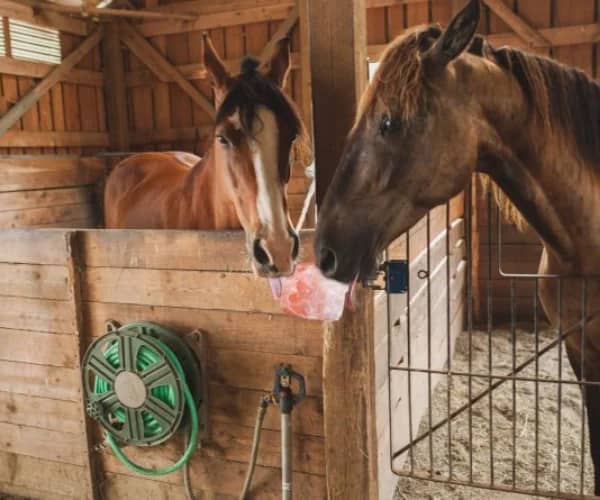
Salt licks are basic mineral blocks critical to the health of many types of animals, from livestock to wild ones. But what makes them so important to animal health? And do animals enjoy the taste of them at all? This paper looks into the scientific basis behind using salt licks for animals and their practical advantages considering their contribution to animal nutrition and behavior.
What is a Salt Lick?
Salt licks can be created naturally or artificially; either way, they offer an easy source of essential nutrients. which might be absent in an animal’s regular diet. Common ingredients include sodium chloride (table salt) –– calcium, phosphorus, magnesium (another mineral), zinc & selenium are some trace elements found within these blocks. Animals like to lick salty things most of the time. Salt licks are the best option for animals to lick in their daily diet.
Why Do Animals Need Salt?
Nutritional Needs
Salt is necessary for an animal’s diet because it provides sodium and chloride – two key elements needed for various physiological processes such as nerve function muscle contraction fluid balance etcetera; chlorine also plays a major role in digestion besides maintaining cellular integrity on the other hand.
Role Played By Trace Minerals
Apart from most types of salts used which contain sodium plus chloride ions; other essential microelements commonly present include:
Calcium & Phosphorus: mainly responsible for bone development & maintenance;
Magnesium: helps with muscle health since it aids enzyme functions;
Zinc: plays a big part in skin care as well as the improvement of immunity;
Selenium: important for antioxidant protection and thyroid function among others.
Salt licks prevent deficiencies that could lead to slow growth rates, weak immune system or even reproductive failure by providing these nutrients.
How Salt Licks Benefit Livestock?
. Encouraging Growth and Efficiency
. Improving Digestion
. Supporting Reproductive Health
Encouraging Growth and Efficiency
To illustrate, if one has cattle, sheep or goats; it is important to ensure that they are kept near salt licks for animals as this will provide them with minerals required for promoting fast growth rates as well as increasing body weights generally. Animals allowed access to salt licks for animals put on more weight than those denied any which means that besides producing extra milk throughout their lives; they also remain useful all along.
Improving Digestion
Among other things, salt helps digestion, especially in ruminant animals like cows and sheep which have complex digestive systems that require a continuous supply of saliva to break down fibrous plant materials.
Supporting Reproductive Health
Some minerals may be lacking thereby causing poor breeding structure within livestock populations. Thus; by introducing salt licks for animals among other measures, we can guarantee adequate nutrition for all our breeding stock thus enhancing successful conception resulting in healthier offspring and better management practices at the large herd level.
Significance of Salt Lick in Wildlife Management
Natural Behavior and Habitat
Animals in the wild instinctively seek out places with salt deposits – this is why many game reserves are located around natural licks which attract different species from miles away because it does not only benefit personal animals but also plays a big role in wider ecosystem dynamics.
Increasing the Probability of Survival
For their survival under harsh conditions, many types of animals require minerals. They provide nutrients that can help one stay alive better and also support deer’s antler growth as they enhance public health at large.
Human Intervention and Conservation
Artificial salt licks are commonly introduced by gamekeepers to support wildlife populations where there are no natural ones for animals. This may be done in conservation areas or national parks where keeping healthy populations of wild animals is prioritized.
Do Animals Like the Taste of Salt Licks?
Behavioural Observations
Those who have watched over salt licks for animals have noticed that animals appear to love these mineral sources very much. It is not uncommon to find cattle or other livestock spending long hours licking salt blocks; this shows that they know its nutritional value besides being tasty for them.
Scientific Insights
Studies indicate that there is an animal’s physiologically driven natural desire for sodium. Sodium is among those minerals which creatures will go out looking for when they lack from their diet
particularly. The act ensures the appropriate body function balance required by an animal about sodium levels.
Palatability and Formulation
When making salt lick products, manufacturers usually take into account how delicious they should be made to appeal to various animals. This involves mixing different salts with other minerals sometimes adding flavours meant to encourage continued use which leads to good nutrient intake among different creatures.
Common Types of Salt Licks
Natural Salt Licks
These are areas or patches of ground that contain deposits of minerals essential for animals’ healthy growth. Such spots may be rocks with high salt concentrations and other vital elements necessary to support normal metabolic processes like digestion among others in animals’ bodies. Wildlife diet is greatly influenced by these resources because some animals can travel miles just to reach them.
Salt licks for animals that are produced
These take various forms such as blocks, wheels and loose mineral mixes among others. Moreover, they are usually enriched with extra minerals and designed to survive diverse climatic conditions thereby suiting both farms and game reserves.
Flavored Salt Licks for animals
Some salt licks for animals are made tasty by adding ingredients like molasses; apple or berry flavours can also be used for this purpose. These kinds of flavoured licks work best when one wants to attract animals either for hunting or observing purposes but still needs livestock to consume minerals regularly.
Practical Thoughts on Using Salt Licks for Animals
Placement and Accessibility
The most important thing is where to put salt licks for animals, especially those that have been tamed like cows. They should be placed in areas that are easily accessible and often visited by such creatures; this can be near feeding troughs or watering points while in the case of wild game, it could be along known animal paths or close to natural water bodies as well.
Monitoring Usage
Periodically checking how much one lick has been used can provide insight into its health relative to needed minerals in the body system. Overuse may indicate a lack of some nutrients in their diet while no interest towards them means that enough amounts were acquired from other places.
Seasonal Adjustments
Different seasons have different mineral requirements for animals during the hot summer days sweat leads to the loss of more electrolytes hence increasing the demand for salt. Therefore changing the availability/formulation of salt licks for animals according to seasonal needs will help keep various species healthy.
Conclusion:
Salt licks are necessary for domesticated animals and wildlife because they contain the minerals needed for growth, health and survival. These minerals, obtained from natural deposits or artificially made blocks also help provide nutrition as well as influence behaviour among various species of animals. Every living organism desires to obtain some salt which is why they will search for it wherever possible thus being one of the best ways known so far to keep healthy those creatures under human care.
Also visit: Usblogsphere






Bwer Company is a top supplier of weighbridge truck scales in Iraq, providing a complete range of solutions for accurate vehicle load measurement. Their services cover every aspect of truck scales, from truck scale installation and maintenance to calibration and repair. Bwer Company offers commercial truck scales, industrial truck scales, and axle weighbridge systems, tailored to meet the demands of heavy-duty applications. Bwer Company’s electronic truck scales and digital truck scales incorporate advanced technology, ensuring precise and reliable measurements. Their heavy-duty truck scales are engineered for rugged environments, making them suitable for industries such as logistics, agriculture, and construction. Whether you’re looking for truck scales for sale, rental, or lease, Bwer Company provides flexible options to match your needs, including truck scale parts, accessories, and software for enhanced performance. As trusted truck scale manufacturers, Bwer Company offers certified truck scale calibration services, ensuring compliance with industry standards. Their services include truck scale inspection, certification, and repair services, supporting the long-term reliability of your truck scale systems. With a team of experts, Bwer Company ensures seamless truck scale installation and maintenance, keeping your operations running smoothly. For more information on truck scale prices, installation costs, or to learn about their range of weighbridge truck scales and other products, visit Bwer Company’s website at bwerpipes.com.
Keep up the fantastic work! Kalorifer Sobası odun, kömür, pelet gibi yakıtlarla çalışan ve ısıtma işlevi gören bir soba türüdür. Kalorifer Sobası içindeki yakıtın yanmasıyla oluşan ısıyı doğrudan çevresine yayar ve aynı zamanda suyun ısınmasını sağlar.
Noodlemagazine I’m still getting into blogging, but I deeply appreciate your content. This article genuinely caught my eye. I’ll bookmark your site and check back often for updates.